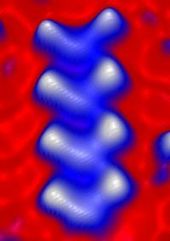
This wire, called a superconductor, actually is four pairs of organic salt molecules and is less than 1 nanometer wide.
That's so small that even electron microscopes can't see it. The newsprint this story is on is about 100,000 nanometers thick.
The discovery could help pave the way toward a new generation of miniature wiring that would further shrink the size and boost the power of cell phones, computers and other devices.
"You could have a laptop that's as powerful as a supercomputer," said Saw-Wai Hla, an associate professor of physics who helped create the supersmall wire. "From that point of view, it's really exciting."
The problem with standard electrical wire is that the smaller it is, the more heat that builds up from resistance to the flow of electrons. A small wire can melt under the stress.
Superconducting materials have an electrical resistance of zero and can carry large electrical currents without generating heat or losing power.
Superconductors are used today in applications such as supercomputers and brain-imaging devices.
Hla's findings, published in Nature Nanotechnology, mark the first creation of a superconductor on such a minuscule scale.
There are obstacles to overcome before this discovery makes it to your iPod. The organic salt circuit performed best at a temperature of about minus-441 degrees Fahrenheit.
It had to be tested in a vacuum similar to that found in space. Why? A single air molecule could have dislodged it and disrupted the experiment.
"Somebody will have to look for different materials that can work at higher temperatures," Hla said. "This (discovery) shows it can be done."
Still, James Brooks, a Florida State University physicist, is excited by the research.
"They've solved a problem in how to make this particular type of material work on a nano-scale," Brooks said. "It's significant."



Reader Comments
to our Newsletter